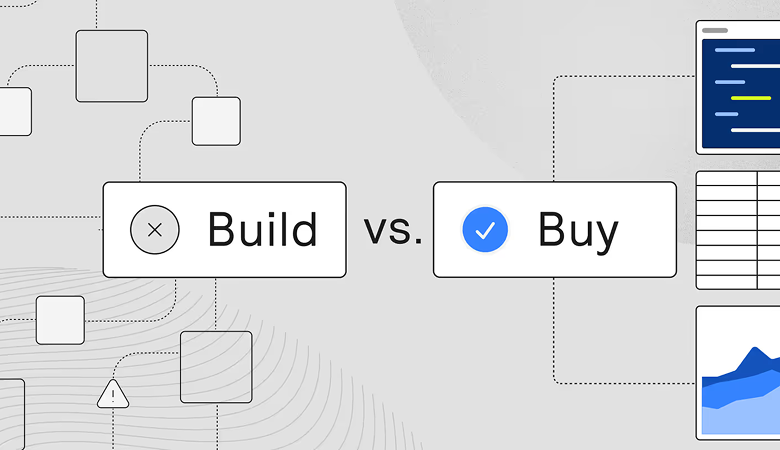What is revenue forecasting?
Revenue forecasting is the process of predicting how much money a company will earn over a future period. For SaaS businesses, this means estimating recurring income (usually monthly or annually) from subscriptions, renewals, and usage-based charges.
The goal is to give your team a forward-looking view that helps with resource planning, cash flow management, and revenue growth decisions. A good sales revenue forecast guides hiring plans, marketing budgets, product development, and fundraising strategies.
Difference between projections vs. actuals in subscription models
Unlike traditional software sales, where deals are one-and-done, SaaS income is recurring. That brings a unique challenge: The gap between projections and actuals. A forecast might assume customers will stay subscribed, upgrade, or use more of a product.
But churn, delays in onboarding, or usage drops can pull actual numbers far off course. That’s why tracking plan vs actuals matters so much in a subscription model. Negative or positive variance between expected and real revenue can trigger major strategy shifts.
Traditional revenue forecasting models rely on spreadsheets, periodic reporting, and static data snapshots. They work for linear sales models, but fall short in subscription businesses. SaaS revenue forecasting models are different.
Note: Forecasting revenue growth in SaaS firms is tightly connected to how you price and bill. Subscription tiers, usage-based pricing, and hybrid models all affect how predictable or volatile your revenue can be. That’s why SaaS billing software and pricing model design play a direct role in how accurate your forecasts are.
Why SaaS revenue forecasting needs to be specialized
Forecasting in SaaS companies shapes everything from board decisions to payroll planning. When done right, revenue forecasting becomes the foundation for aligning teams, setting goals, and preparing for growth. Forecasting helps SaaS leaders:
- Match resources to demand
- Make confident cash flow decisions
- Hit long-term growth targets
- Avoid overspending or missed hiring opportunities
It also plays a major role in board reporting. Investors want clarity. A clear sales revenue forecast backed by solid metrics (like ARR and churn) builds confidence.
It shows you know what’s coming and how you’ll get there. Recurring revenue makes this even more powerful because of how stable and predictable it can be, when you use purpose-built revenue forecasting models that reflect your pricing and billing structure.
The unique challenges SaaS forecasting faces
SaaS forecasting models deal with problems most other businesses don’t have. Let’s zoom in on what those are.
Churn
Every customer has a choice to leave. One month they’re active, the next they’ve canceled. A small churn rate can have a big impact on revenue over time. Forecasts must factor in signs of disengagement early, like lower feature usage or rising support requests.
Expansion MRR
Growth doesn’t always come from new customers. Many SaaS companies grow through upsells and cross-sells. That extra revenue (expansion MRR) is less predictable and needs to be modeled differently from base subscriptions.
Usage variability
More companies are adopting usage-based pricing. Forecasting becomes harder when revenue depends on how much of something (API calls, seats, data storage) your users consume. You need to estimate consumption, not just headcount.
Subscription renewals vs. one-time sales
With subscriptions, your revenue forecast depends on renewals, not just new sales. That means your models must account for timing, engagement, and customer health.
Traditional forecasting tools treat sales as “won” or “lost.” But SaaS deals can shrink, expand, or churn over time, and that changes everything.
Why generic models fall short
Generic forecasting tools don’t track recurring revenue accurately. They miss the impact of churn, ignore expansion, and can’t model usage-based charges in real time. SaaS finance teams need revenue forecasting models that adapt to how they sell and bill, not outdated templates made for physical product sales.
Key SaaS metrics for forecasting
SaaS companies rely on revenue forecasting to make smarter business decisions. But no forecast is useful without the right SaaS metrics feeding into it. These metrics tell you where your revenue is coming from, how stable it is, and what’s likely to change.
Below are the core metrics that shape every accurate revenue projection model:
- Monthly recurring revenue (MRR): MRR tracks predictable monthly income from subscriptions. It’s the foundation for most SaaS forecasts. Use it to monitor short-term growth, spot plateaus, and model future revenue trends.
- Annual recurring revenue (ARR): ARR gives you a longer-term view. Multiply MRR by 12, or factor in expansion and churn for more accuracy. ARR is often used for board reporting and profit projections.
- Churn rate: Churn shows how many customers cancel or downgrade. It directly impacts recurring revenue. Forecasts must account for churn to avoid overestimating revenue from existing accounts.
- Customer lifetime value (LTV) and customer acquisition cost (CAC): LTV tells you how much value a customer brings over time. CAC tells you how much it costs to get them. Together, the LTV:CAC ratio helps predict sustainable growth and refine your forecast model.
- Usage metrics: In usage-based pricing, what a customer does drives revenue. Track things like API calls, seats, or data usage. These metrics feed usage-based forecasts and help manage capacity planning.
Note: While forecasting is about the future, accurate reporting depends on proper revenue recognition. SaaS teams must also reconcile forecasted numbers with actual billing, revenue events, and GAAP rules. The best revenue forecasting software helps tie forecasts to real revenue data.
Revenue forecasting models tailored to SaaS companies
Subscription models are fluid, renewals, upgrades, and usage all change how money flows in. SaaS companies need forecasting methods that reflect how revenue actually works in a recurring model. Here are four forecasting methods built for the SaaS industry.
Cohort-based forecasting
Cohort forecasting groups customers by a shared trait, like signup month, plan type, or feature usage. For example, a “January 2024” cohort might show lower churn or higher upsell rates than other months.
By tracking cohorts over time, you can predict how similar future customers will behave. This method is especially helpful for forecasting renewal patterns, product adoption, and long-term MRR performance.
Subscription renewal forecasting
In SaaS, renewals are where the money is. This model predicts revenue based on current contracts set to renew. It accounts for expected renewal rates, probability of upgrades or downgrades, and customer health indicators.
Subscription renewal forecasting works well for stable customer bases where retention plays a larger role than net new sales.
Usage-based forecasting
SaaS companies that bill by API calls, active users, or data usage need to predict more than just subscriptions. This model analyzes usage trends to estimate future consumption. You might forecast API usage based on seasonality, growth in customer headcount, or adoption of new features.
Remember: This method is vital for revenue forecasting software platforms that meter and bill in real time.
Hybrid and blended models
Many SaaS companies now mix subscriptions with usage-based pricing. A customer might pay a flat rate, then get billed extra for overages.
Hybrid forecasting requires combining subscription renewal predictions with metered consumption trends. The model works well for companies transitioning pricing strategies or serving multiple customer segments with different billing structures.
Choosing the right model for your business
Your stage of growth, data maturity, and pricing model all shape what will actually work. The best approach is the one that reflects your current business reality, without overcomplicating things. Here’s when to apply different forecasting models, based on the company’s phase:
- Startup phase: Early-stage teams should keep forecasting light and practical. Use basic cohort analysis or historical trends to identify early revenue patterns. Focus on what’s predictable, like signup rates or plan mix, rather than usage or churn.
- Growth phase: As go-to-market efforts expand, combine pipeline-driven sales forecasts with cohort analysis and usage trends. Layering these data points gives a fuller view of future revenue.
- Mature phase: Larger SaaS companies need models that can simulate different futures. Tie revenue to real-world drivers (like retention rates, NPS, or feature adoption) and model multiple outcomes using scenario planning.
Match model complexity to business stage
Your forecast model should be only as detailed as your team and systems can support. Starting too complex leads to errors. Over time, increase precision by layering in more signals like expansion revenue, renewals, and usage triggers.
Data reliability matters
Before scaling a forecast, make sure your data is clean and centralized. Inconsistent inputs make any model unreliable. Connect billing, usage, and CRM data to create a trusted source of truth.
Sometimes you need a combo
Companies in transition — shifting pricing models or scaling teams — often need blended forecasts. For example, renewal-based projections for legacy customers and usage-based models for newer accounts. Mixing models is fine, as long as each one maps to how revenue actually works in that segment.
Building your forecast: A step-by-step guide
Forecasting future revenue is a structured process based on data, real behavior, and known pricing mechanics. Below is a practical guide for building your own SaaS revenue projection model step by step.
Step 1: Gather clean, centralized data
Begin by pulling together your most important financial and operational data. This includes active subscriptions, historical MRR, billing records, CRM pipeline data, churn logs, and product usage metrics like seat count or API volume. Consistency is essential; aligning customer identifiers and standardizing units will save you from misleading insights later.
The ideal setup connects tools like Stripe, Salesforce, and Segment into a single reporting layer or data warehouse. Automated syncing through APIs reduces human error and improves data freshness.
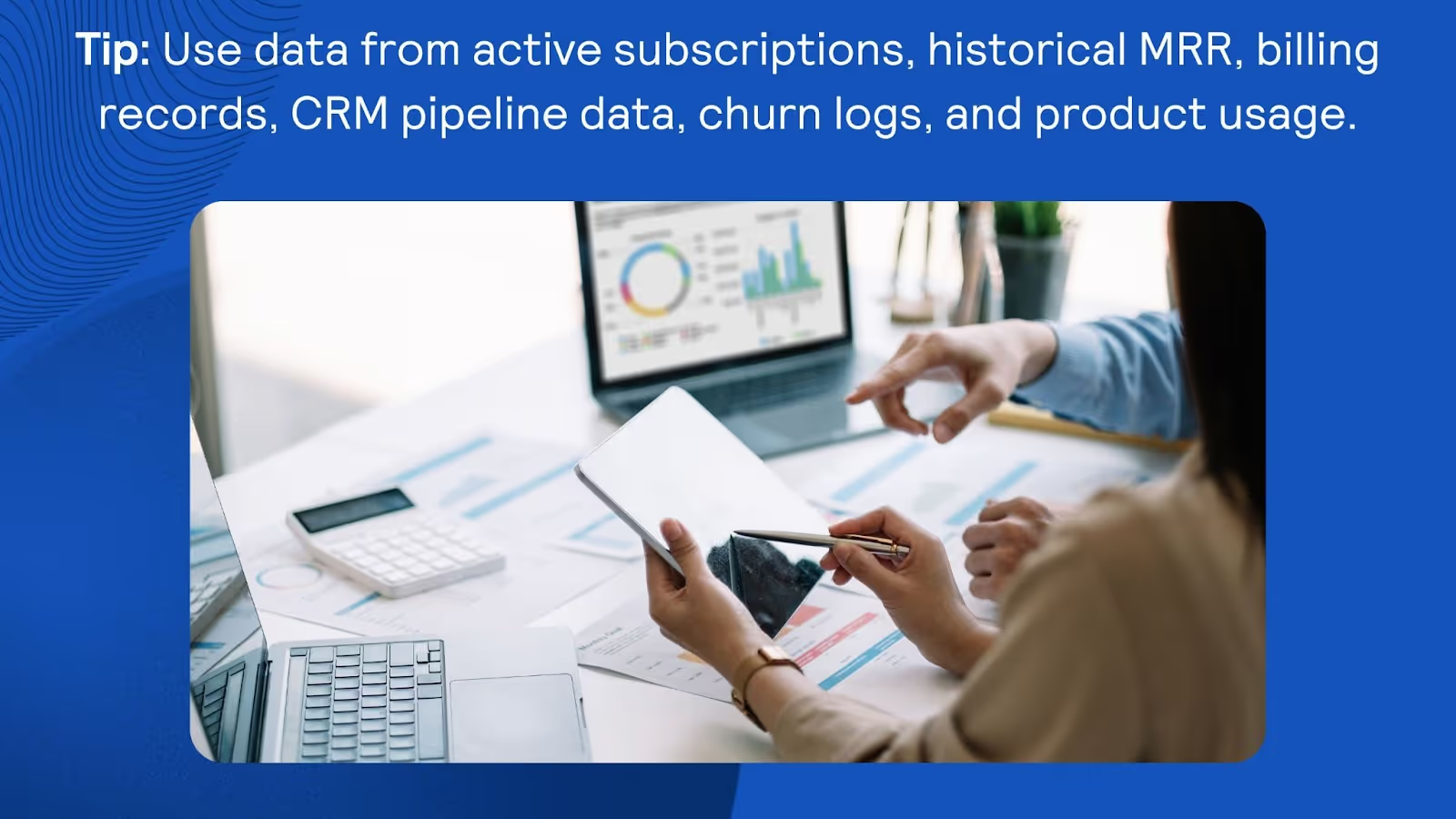
Step 2: Segment customers or revenue streams
Next, group your customers in ways that reveal different revenue behaviors. This might be by signup month (cohort), product tier, geography, or billing frequency. For example, monthly plan users in Europe may churn faster than annual customers in North America.
Segmentation exposes hidden trends in churn, expansion, and LTV. Use tools that let you filter cohorts or tag accounts for deeper analysis. These insights will help you fine-tune your revenue projections across different parts of your business.
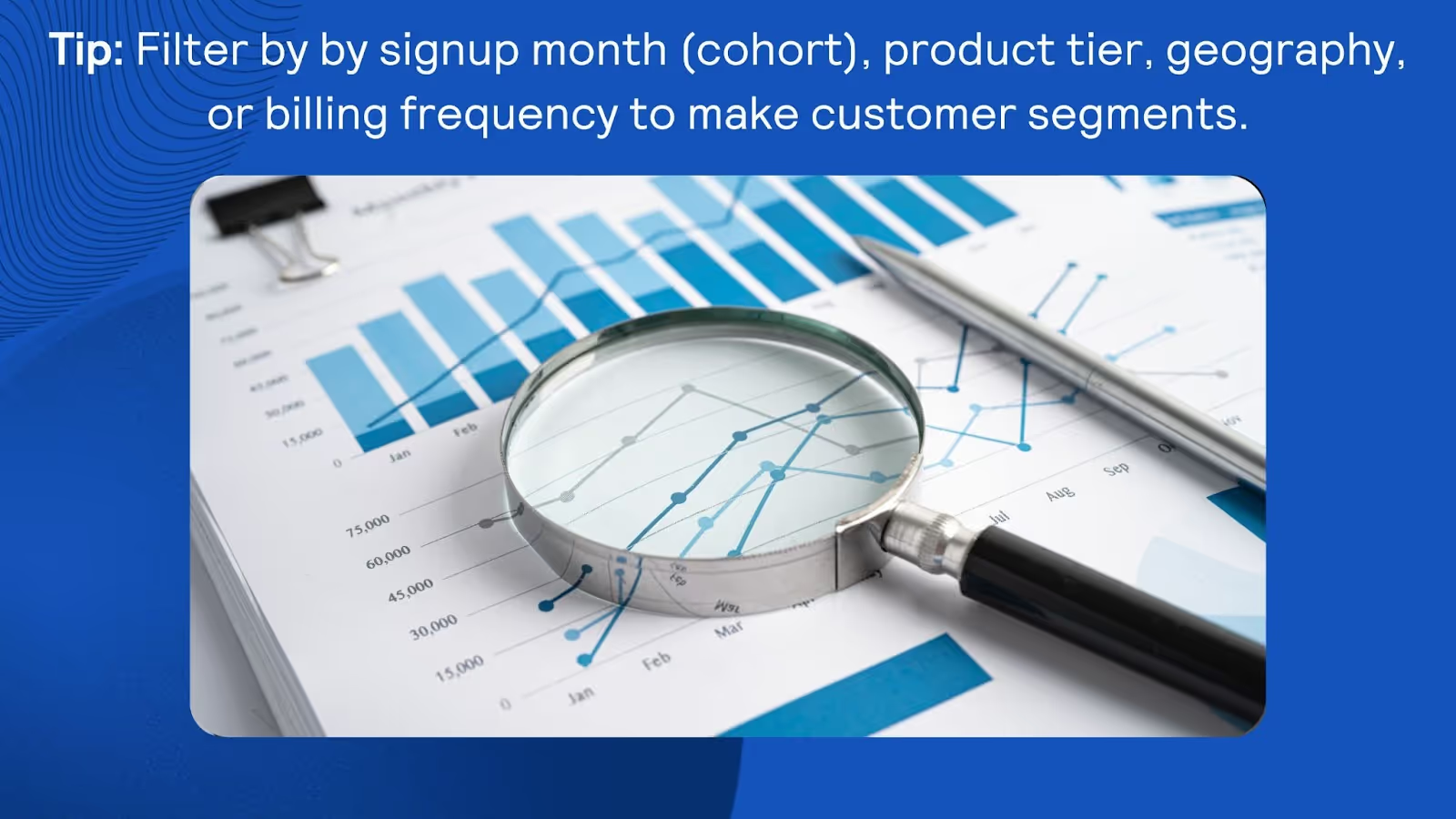
Step 3: Choose your revenue projection model
Now it’s time to choose a forecast structure that reflects your revenue sources and growth stage. Early-stage companies may stick to linear trends or cohort-based forecasting. More mature SaaS firms benefit from blending pipeline forecasts, renewal logic, and usage-based projections.
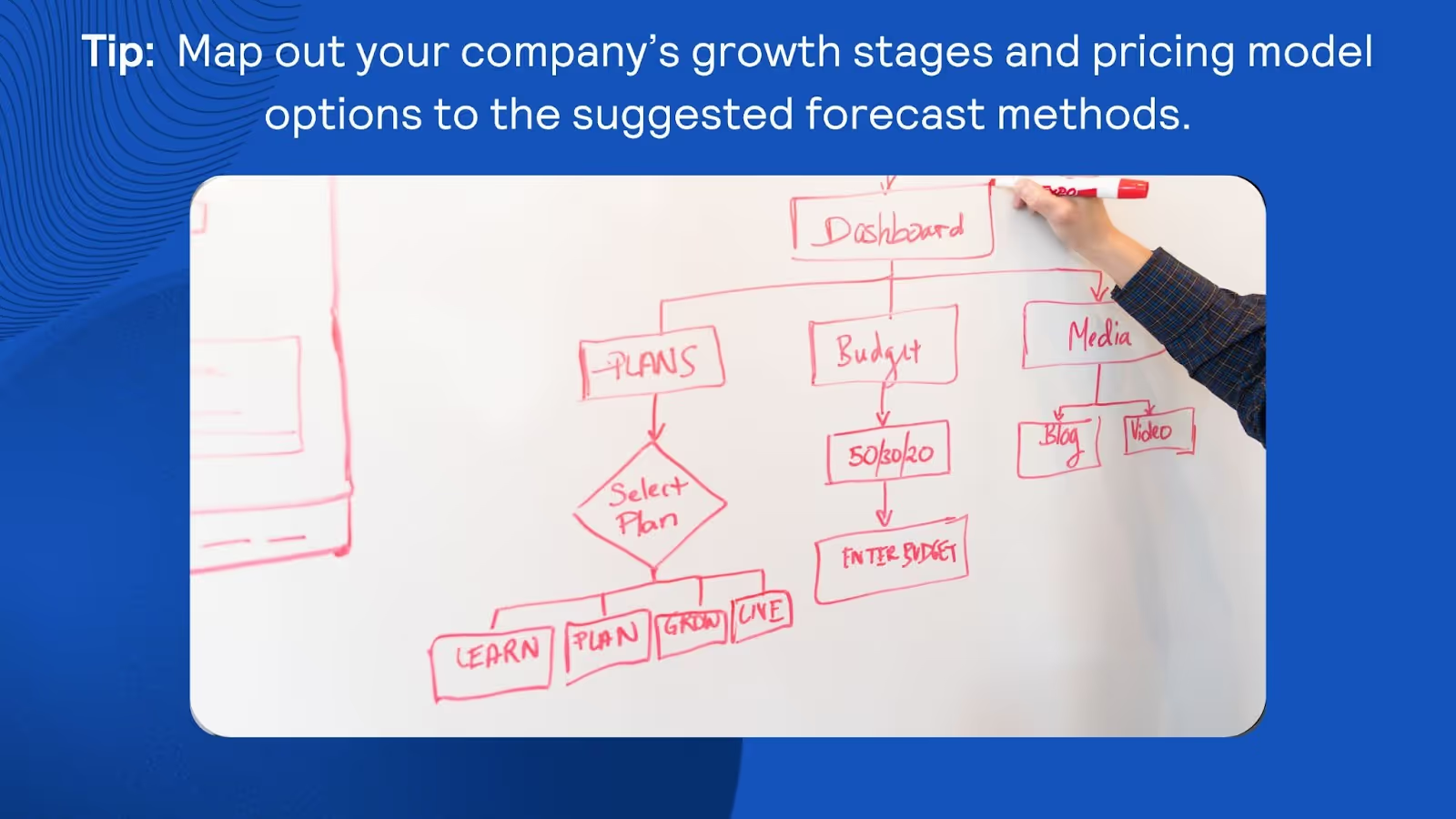
If your pricing model includes both flat-rate subscriptions and metered billing, you may need a hybrid model. Don’t overbuild at first. Choose a setup that your team can maintain and scale as you grow.
Step 4: Define key inputs and revenue drivers
With your model structure set, pinpoint the variables that most influence revenue. These might include net new MRR from sales, expansion revenue from upsells, monthly churn rate, or usage metrics tied to billing.
Set baseline values using trailing averages or rolling medians. Track each input in your forecast model and clearly document the logic behind them, especially for assumptions like renewal probability or average seat expansion.
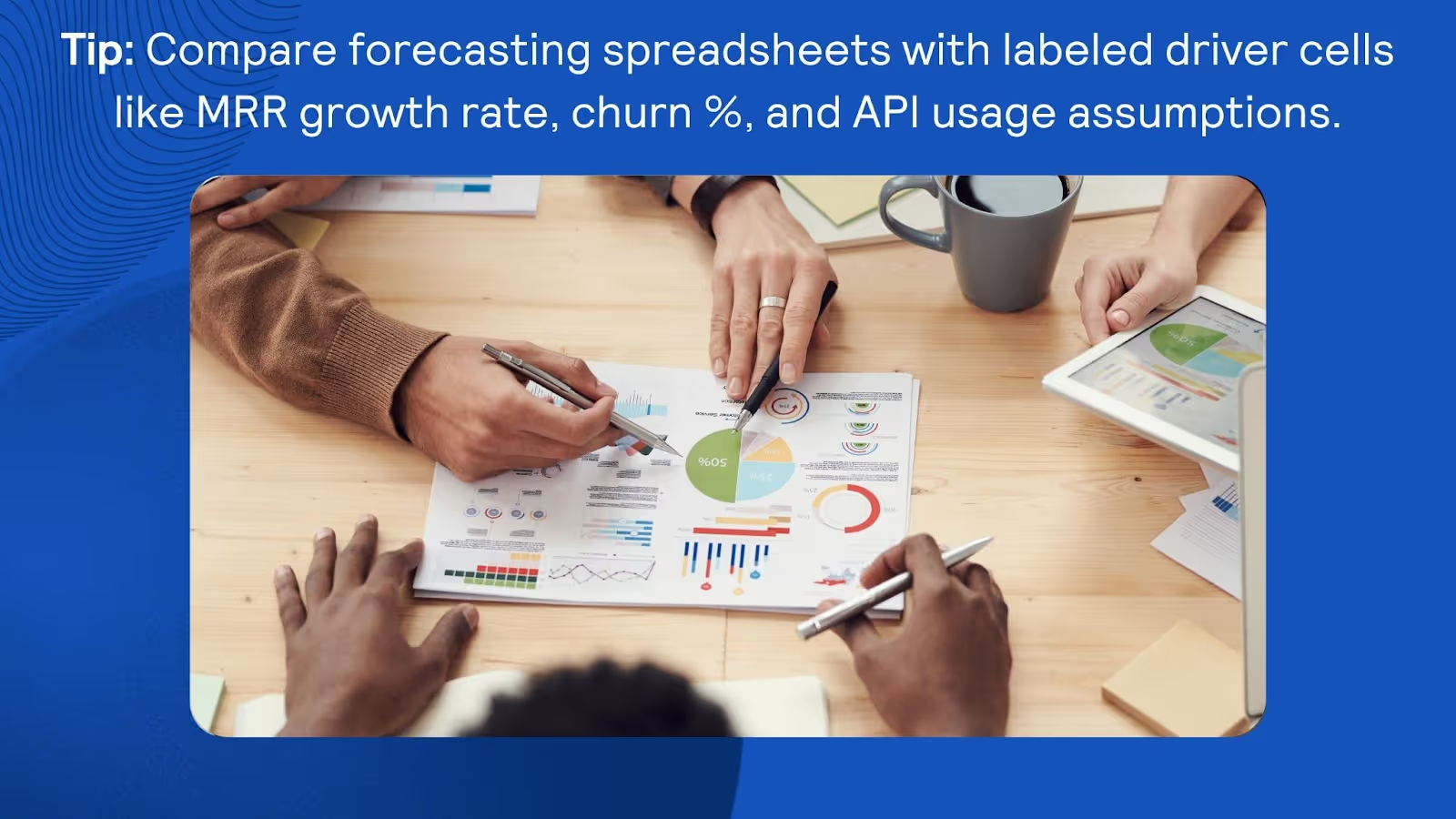
Step 5: Build the forecast and run calculations
Populate your model with historical and projected inputs. Break revenue into components (new business, expansion, renewals) and calculate how they change month over month. If you use consumption pricing, integrate expected usage volumes based on historical trends.
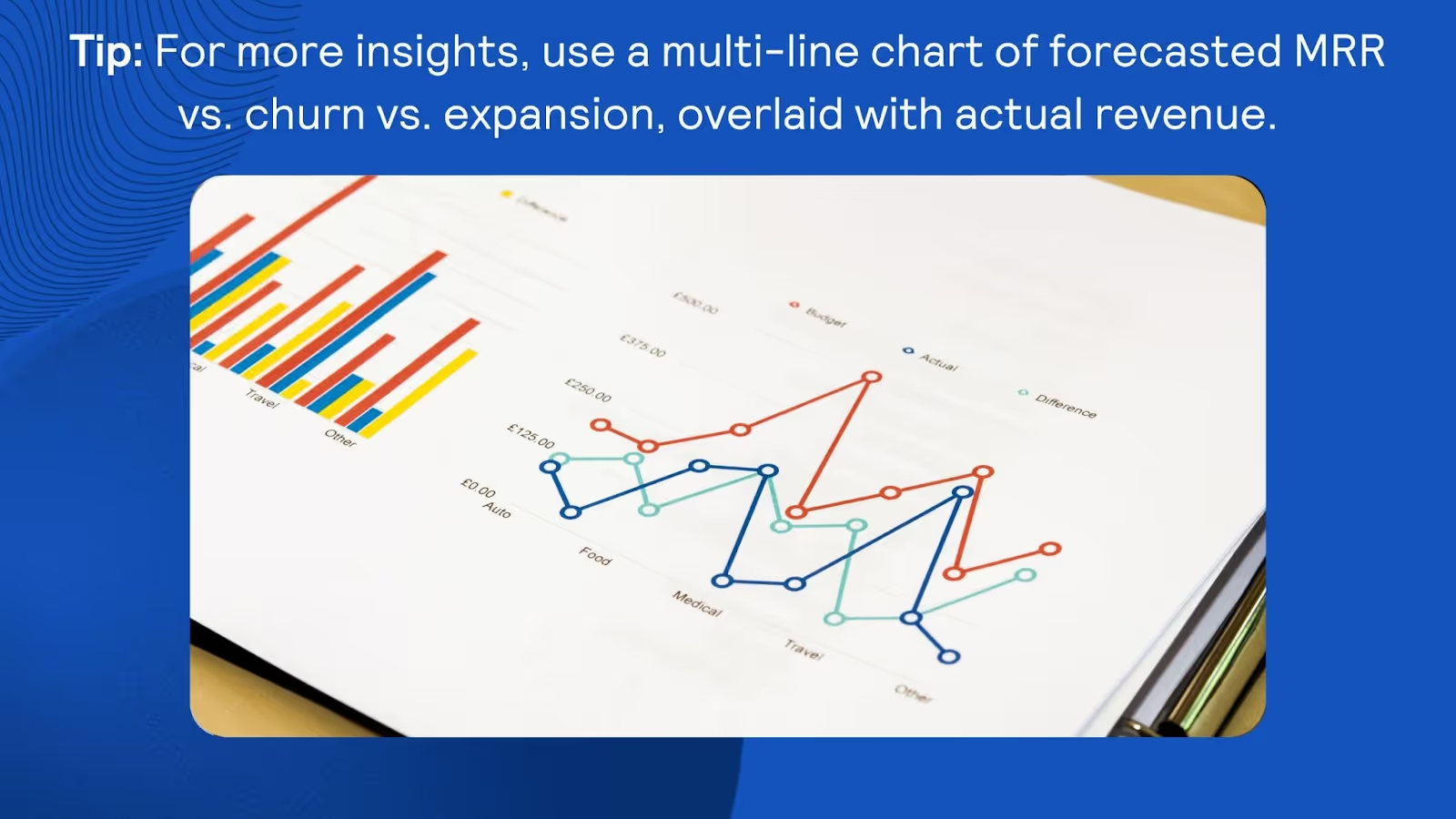
Create different scenarios (baseline, optimistic, conservative) if you want to model risk. Be sure to separate recognized revenue from bookings or billings when needed for accounting clarity.
Step 6: Validate against actuals regularly
Every forecast is a hypothesis. You’ll need to compare it to real-world results to see how accurate it was. Look at how projected MRR, churn, or usage matched up against actual outcomes. Where you missed the target, dig into the “why.”
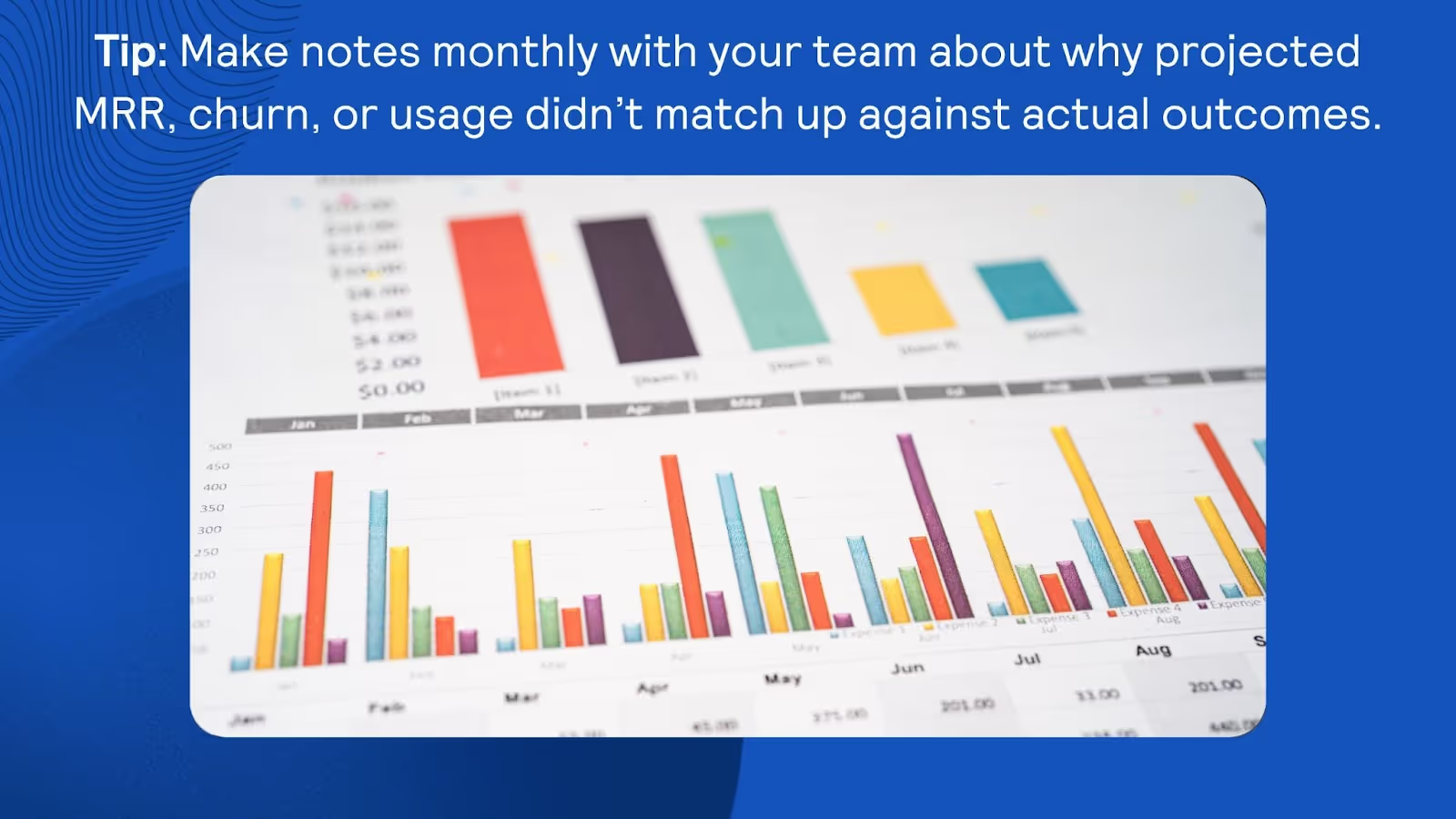
Remember that monthly variance tracking helps improve future accuracy. Make sure to also document lessons learned and keep iterating.
Step 7: Automate updates and maintain forecast hygiene
Set up systems to update your forecast automatically with the latest data. For example, connect your billing platform via API to pull updated MRR and churn logs. Set a cadence (weekly or monthly) for refreshing the forecast based on new usage, pipeline, or customer activity.
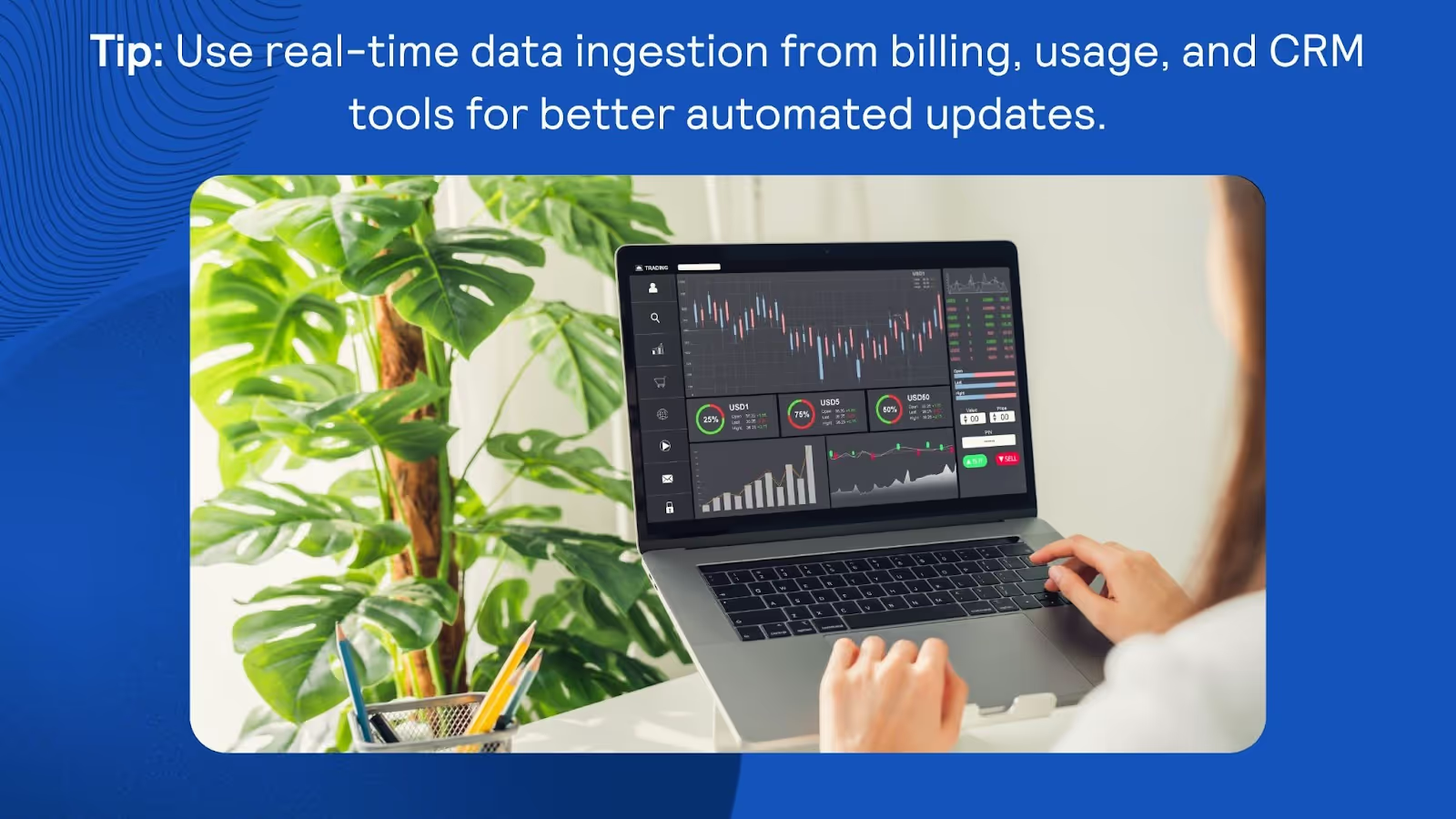
If you manage multiple forecast versions, track changes to assumptions over time. Always check for broken formulas or outdated links if you use spreadsheets.
Step 8: Share, document, and explain the forecast
A forecast is only useful if people understand it. Present your outputs in a clear format — include headline metrics, the assumptions you made, and which scenarios are most likely. Sales, product, and finance teams should all walk away knowing what to expect and where the risks lie.
Use visuals and short written summaries. When possible, explain not just the numbers, but the behavior behind them (e.g., “We expect churn to rise in Q3 due to sunsetting a legacy plan”).

Remember: Knowing how to calculate projected revenue is only half the battle. SaaS forecasting is about adapting to how your customers pay, use, and renew, not just plugging numbers into a template.
Example case studies: How SaaS clients use forecasting
Below are two real-world-inspired examples showing how SaaS companies apply forecasting techniques to solve different business problems. Let’s look at each example closely.
Example 1: Reducing forecast error by 20% through usage-based adjustments
A mid-market DevOps platform was consistently missing its monthly MRR targets. After an internal review, the finance team realized their forecast model treated all accounts equally, despite 60% of their revenue being usage-based.
By integrating actual usage data (API calls and storage metrics) into their forecast inputs, they began modeling expected consumption based on seasonality and historical growth patterns. Within one quarter, forecast variance dropped by 20%.
This shift gave leadership more confidence in short-term hiring and infrastructure investment plans.
Example 2: Improving renewal accuracy with real-time entitlement tracking
A vertical SaaS company serving the healthcare industry struggled to predict contract renewals. Many customers were on custom plans with dynamic entitlements, and the team lacked visibility into who was nearing capacity limits or dropping off.
They adopted real-time entitlement tracking tied to usage logs and customer health metrics. The customer success team flagged at-risk accounts earlier, while finance used renewal probabilities to better project revenue.
Over two quarters, they reduced unexpected churn by aligning support and product interventions with forecast signals.
Common pitfalls in revenue forecasting
Even strong SaaS teams run into forecasting issues. Below are some of the most frequent mistakes that weaken accuracy:
- Overlooking churn and contraction: Focusing only on new bookings and forgetting the revenue lost to downgrades or cancellations leads to overly optimistic forecasts.
- Relying on static spreadsheets instead of live models: Spreadsheet-based forecasts are slow to update, hard to audit, and prone to human error. SaaS companies need dynamic, real-time models.
- Ignoring seasonality and mid-cycle pricing changes: Annual renewal cycles, usage peaks, and pricing shifts impact revenue timing. Flat-line growth assumptions miss the nuance.
- Failing to involve Sales and RevOps: Sales teams have visibility into deal health, stage velocity, and push risk. Without their input, pipeline-driven forecasts often misfire.
- Mixing billing logic with recognized revenue: Forecasts based on bookings or invoices without GAAP adjustments can confuse cash flow with true earned revenue.
Best practices for SaaS revenue forecasting
Great revenue forecasting starts with the right habits. These best practices help SaaS teams stay aligned and adaptive as they grow. These are some key best practices:
- Establish a single source of truth: Centralize data from billing, CRM, product usage, and customer success tools into one reporting layer to avoid conflicts and gaps.
- Review forecasts monthly, and after major product or pricing updates: Static plans don’t work in SaaS. Refresh regularly to reflect changing customer behavior and go-to-market motions.
- Collaborate across Finance, Sales, RevOps, and Product: Each team holds pieces of the forecasting puzzle. Pull insights from pipeline data, churn signals, and feature usage to improve assumptions.
- Document assumptions and track forecast accuracy over time: Write down growth rates, churn estimates, and usage inputs. Revisit regularly to see where the model performed well or fell short.
- Create version control for models and scenarios: When conditions change, you’ll want to revisit past assumptions. Keep clean archives of forecasts and decisions for reference.
- Build for change, not perfection: Revenue forecasts aren’t meant to be right — they’re meant to be useful. Build models that adjust quickly as you learn more.
Accurate revenue forecasting starts with Orb
Revenue forecasts are only as strong as the systems behind them. If you're working from stale spreadsheets, disconnected data, or billing tools that weren’t built for SaaS, your forecasts will always be a step behind your growth.
Orb is the done-for-you billing platform that helps SaaS firms unlock their usage data, allowing flexible pricing, seamless billing, and faster growth. By ingesting every usage event and decoupling pricing metrics from usage data, Orb becomes the foundation for accurate revenue forecasting.
Here’s how Orb helps you build forecasting models that reflect the real state of your business:
- See usage in real time and forecast based on value: With Orb RevGraph, every raw event is tracked and stored with full fidelity. You can forecast confidently, using real product usage data across cohorts, customer segments, and pricing tiers.
- Model pricing changes before they go live: With Orb Simulations, you can test pricing strategies using real historical usage data before making changes that affect revenue or risk churn. Run side-by-side simulations, compare outcomes, and select the model that drives better revenue projections.
- Maintain precise, auditable billing, even with frequent pricing changes: Because Orb ingests all raw event data and doesn’t drop events, its billing is extremely accurate. Invoices are generated using raw event-level inputs, with full transparency into how every line item is calculated.
- Support any pricing model your business evolves into: Forecasting is more reliable when the billing engine can adapt to new models without engineering rewrites. Orb offers unparalleled flexibility, empowering companies to implement any pricing model, including tiers, subscriptions, usage-based, prepaid credits, multi-dimensional, and more.
- Turn forecasting into a collaborative, cross-functional process: Orb breaks down silos by offering an easy-to-use unified data layer. Product teams can define billable metrics using SQL or a visual editor, finance teams can analyze historical revenue trends, and leadership teams can simulate pricing changes and forecast revenue. Everything lives in one place and updates in real time.
Ready to forecast, price, and bill with confidence? See how Orb can support your growth stage and forecasting needs.

.avif)

